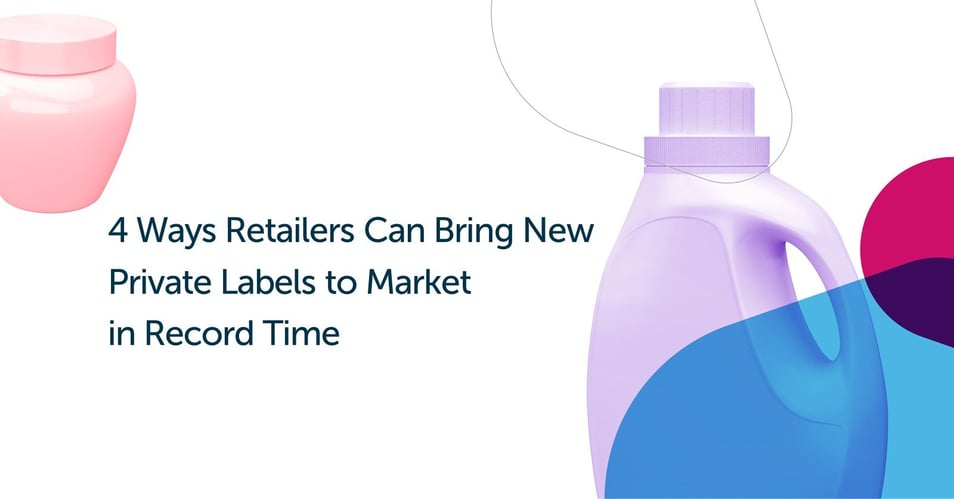
4 Ways Retailers Can Bring New Private Labels to Market in Record Time
Time is money and today global retailers face an exciting opportunity to grow by responding to consumers’ evolving needs – faster than their rivals do. Specifically, retail buyers can gain a competitive advantage with private label products, which are in demand around the world right now, by using product sourcing best practices that boost efficiency.
According to a 2020 McKinsey report, COVID-19 has eroded brand loyalty, with 25% of consumers trying new private-label brands during the pandemic and 80% of them intend to continue using them after the pandemic ends. Private labels help retailers differentiate their offerings, increase their margins and delight consumers with products that reflect their values, including sustainable, healthy and local goods. Retailers whose private labels promptly respond to consumer values can gain a competitive advantage, sales and loyalty.
Notably, private label speed requires efficient, agile collaboration between retailers and consumer-packaged goods (CPG) manufacturers. That’s because retailers that successfully bring their innovative products to market faster can delight consumers (and start earning revenue) sooner.
Here are four ways retail buyers can save time on private label sourcing.
1. Discover great products faster
For attractive, lucrative assortments, retail buyers traditionally attend online or in-person trade shows and events, and create RFIs, RFQs and RFPs to source the right products for their market’s needs. As a result, buyers spend a significant amount of time trying to find goods that can enhance their private label offerings by keeping up with consumer trends.
Especially during the pandemic, more retailers are turning to online networks to efficiently source innovative products that reflect consumers’ diverse needs. New retail resources help buyers search for, discover and compare products that align with emerging consumer trends.
2. Quickly evaluate manufacturers
Once a retail buyer finds potential suppliers of in-demand goods, the next step is to connect with them to assess their suitability for new private label initiatives, whether it’s a single product or an entire range. This assessment process is often time-consuming. Also, limited and inconsistent information among prospects makes it more challenging for retail buyers to compare manufacturers for their reliability and quality.
A growing number of buyers save time by finding existing suppliers who already create the types of products that shoppers want, which saves time by flattening the learning curve. Buyers contact manufacturers directly to request quotations and product samples to verify product features and quality. Retail buyers also focus on manufacturers’ expertise and relevant certifications to protect consumer safety and product quality. To qualify their network faster, buyers can shortlist suppliers, and compare and analyze their offerings to ensure a good fit for short-term projects as well as potential long-term partnerships.
3. Negotiate better to gain an edge
By their nature, retailers’ relationships with private label manufacturers are more intimate than their relationships with private brands. As such, retail buyers that negotiate with potential private label partners strive for fair deals that satisfy both parties, protect consumers and preserve the integrity of the business relationship. At times, a sense of urgency to react to consumer demand could lead to compromises in negotiations with product manufacturers.
By contrast, more buyers now boost their bargaining power by preparing thoroughly with competitive market data and multiple prospective manufacturers. By studying their options and knowing their essential requirements and boundaries, retail buyers can challenge suppliers on such issues as the price of existing products to secure their desired margins. They can also proactively negotiate product quality standards, sustainable packaging and delivery timelines to ensure safety, reduce risk and control costs.
4. Streamline communications
Currently many private label teams use multiple methods of information-sharing, which can range from generic tools like email, spreadsheets and phone calls to specific resources like Dropbox, Google Drive and Slack. Using a wide variety of communication methods can create a disconnect among private label team members and retail partners by compartmentalizing their communications. As a result, team members often spend time searching for information they need but can’t immediately find due to fragmented communications.
Now a growing number of retail buyers use a single, online source of information to centralize all their private label efforts with their internal teams and external retail partners. Simplifying their communication methods gives retailers a more efficient, unified approach to private label collaboration. As a result, retail teams can focus more of their time on private label innovation rather than collecting data from multiple sources.
Why retailers need speed in 2021
More than ever, retail resilience requires efficient product sourcing practices to help retail buyers move their businesses forward with retail collaborations that lead to desirable private label products. These productivity best practices help global retailers launch in-demand private labels faster, earn bigger margins and delight consumers sooner with products they love.
The global retail industry’s urgent need for efficiency prompted collaborative consumer goods platform Trace One to expand its suite of CPG product development solutions. To help counter retail’s complex, constantly-evolving environment, it recently launched the Trace One E-Sourcing solution, which includes RFX processes to maximize product sourcing and development efficiency so retailers can thrive by getting private labels to market faster.